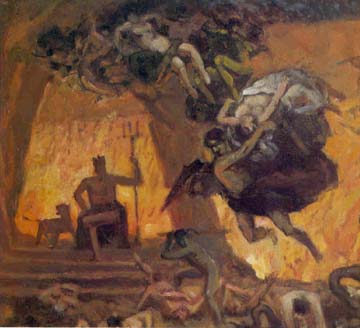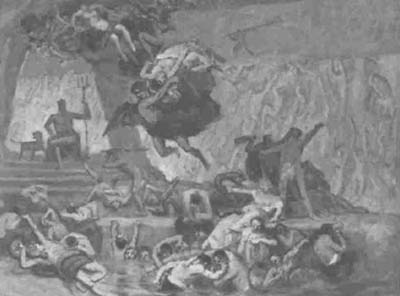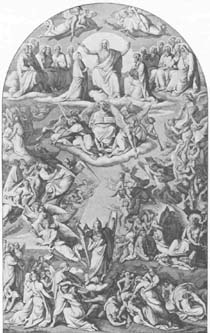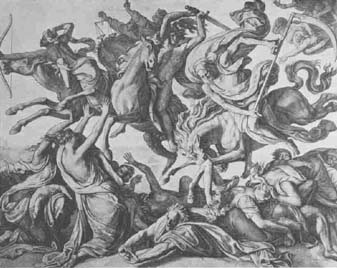
Annual Bulletin 2, 1978-1979
Home
Français
Introduction
History
Annual Index
Author &
Subject
Credits
Contact





The Charles Huot Paintings in
By evoking the triumph of the Saviour at the end of the world, these
paintings would convey "an uplifting message to all who saw them." The
walls of the sanctuary were reserved for the glorification of the Apostolate,
in this case of the Oblate Fathers.
Saint-Sauveur Church, Quebec City
by Sylvain Allaire
Article en français
Pages 1 | 2
| 3
The different stages of the renovation of the Saint-Sauveur church in Quebec City, begun
the year after the fire of 1886, are documented in the parish archives.
"The Fathers [OMI] of Saint-Sauveur received permission on 5 March [1886]
to decorate the interior of the church provided they receive donations
for this purpose." (1) The task of decorating the church, part of the lengthy
reconstruction, was given to Charles Huot on 25 January 1887 and was to
be started on 19 May. In 1887, four bells were purchased at a cost of $1,900.
The following year they were replaced by a new carillon costing $10,000,
and the furnace was replaced at a cost of $4,500. The tower was built in
1889 for $7,098 and the tower clock cost $1,800. Huot's contract for thirteen
paintings was worth $5,000, and $4,400 was paid to the Montreal firm
of Rochon and Beaulieu for grisailles and giltwork. (2)
A design for the decoration was quickly
chosen, and the designs and submission tendered by Eugène Hamel
in September 1886 were discarded. (3) The submission by the Montreal painter,
François-Xavier Meloche, was also rejected; his price of $10,000
was too high it appears. We know nothing specific about these proposals
or the requirements of the community as to the choice of subjects and their
arrangement. The first definite statement of how the paintings were to
be positioned came from the parish priest, Father Grenier, in 1888:
They [the five paintings decorating the vault] are to represent the End of the World , the Last Judgment,
Paradise and Hell. The Transfiguration, which is the theme of the festival
of our patron saint, will be near the middle of the church over the pulpit,
between the Last Judgment and the Glory of the Saints in Paradise. Behind
the High Altar and above the Sanctuary we win have Our
Lord calling unto Him all the downtrodden, the disinherited and the poor
sinners....A little lower, on the gospel-side, will be a large painting
representing the Saviour delivering the keys to Saint Peter and sending
the Apostles out to conquer the universe. On the epistle-side, as its
complement, there will be a picture of Him distributing crowns to the
Apostles, the Missionaries and the faithful from all the tribes and nations
on earth. On the gospel-side of the transept there will be an enormous
painting of the Birth of Jesus and the Adoration of the Shepherds and the
Magi, while on the epistle-side, in another part of the transept, a picture
of the same size will depict Out Lord emerging victorious from the tomb
to the great amazement of the Roman soldiers sent as guards by His enemies. (4)
After a twelve-year absence, Charles Huot returned to Quebec City to obtain
this commission. He had been informed shortly before of the intentions
of the Fathers, and so he was full of hope and confidence when he disembarked
in Quebec City on 18 July 1886. (5) In January he was officially given the
commission, and on 4 February he left again for Europe where he would carry
out his task. (6) The fact that Huot was not working on the paintings in Canada
was apparently the cause of some concern, and when it was erroneously announced
that he had died in the fire in the Opéra Comique, in Paris, there
was some thought of finding a replacement. While in Paris, he sought
out illustrations of the subjects to be treated (7) and began the work by
making small sketches. (8)
Late that year, Huot left Paris for
the northern German town of Neukrug to use the studio his father-in-law
had placed at his disposal. He devoted the next two years to painting five
of the canvases. In March 1888 he was considering using a technique given
to him by a Parisian friend, (9) for painting subjects on large canvases,
but he put off using this technique until 1889. In September that
year, an article in the newspaper of a neighbouring town announced that
the last of the five paintings for the vault had been completed and that
Hell (cover, figs 3 and 4) was on view in the artist's studio. (10)
Huot returned to Quebec City for their
installation. Ernest Gagnon viewed them in 1890, mounted on the vaulted
ceiling of Saint-Sauveur. (11) In 1892, Louis Fréchette described
three other subjects that had been added - the Savior Receiving the Afflicted,
Jesus Delivering the Keys to Saint Peter, and Jesus Blessing the Missionaries.
(12)
The Nativity (fig. 13) and The Resurrection (fig. 14) were,
no doubt, completed soon afterward.
In his review, Louis Fréchette
criticized the arrangement of the pictures. The End of the World, the
Last Judgment, and Hell were "rather frightening subjects for a church
vault." Furthermore, Hell was placed right above the pulpit,
while The End of the World (figs 11 and 12) was partly concealed
by the organ chest, and so "you have to put your neck slightly out of
joint to see it - a sacrifice not wholly out of place." It should be
noted that Huot's mounted canvases are the result of a concept of ceiling
decoration that is lacking in unity.
Although the artist had had many opportunities
to find inspiration and had emulated, at least in feeling; two great decorators
- Paul Beaudry (the Opéra) and Paul Chenavard (the design for the
decoration of the Panthéon) - he showed little originality at Saint-Sauveur.
Even though the comparative study of his iconography is as yet
incomplete, the broad range of Huot's sources is very evident: Raphael's
The Transfiguration has been adapted in Huot's work of the
same name (the detail at the foot of the mountain is cropped) (fig. 6);
Hell is taken from a celebrated section of Paul Chenavard's design
for the Panthéon decorations (fig. 5). (13) The End of the World
bears a striking resemblance to The Last Day of Pompeii (1820-1830),
a romantic painting by the Russian painter Karl Pavlovich Bryulov. (14) In
Huot's The Last Judgment (figs 7 and 8), several characters resemble
those in Peter Cornelius's Judgment (fig. 9); (15) and The Nativity and
The Resurrection, which Huot depicted in a number of different ways
during his career, are similar to compositions by Domenichino and Andrea
del Sarto. We know nothing of the composition of the three pictures in
the choir, which disappeared in 1943 during "restorations," but we can
make some guesses based on a photograph taken on the seventy-fifth anniversary
of the renovation. Fréchette only comments on them in passing,
and not very enthusiastically, calling their style "somewhat conventional."
Next Page | Raphael's
Transfiguration
1 | 2
| 3
Annual Index | Author & Subject | Credits | Contact
This digital collection
was produced under contract to Canada's Digital Collections program,
Industry Canada.
"Digital
Collections Program, Copyright
© National Gallery of
Canada 2001"